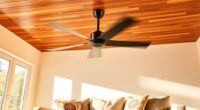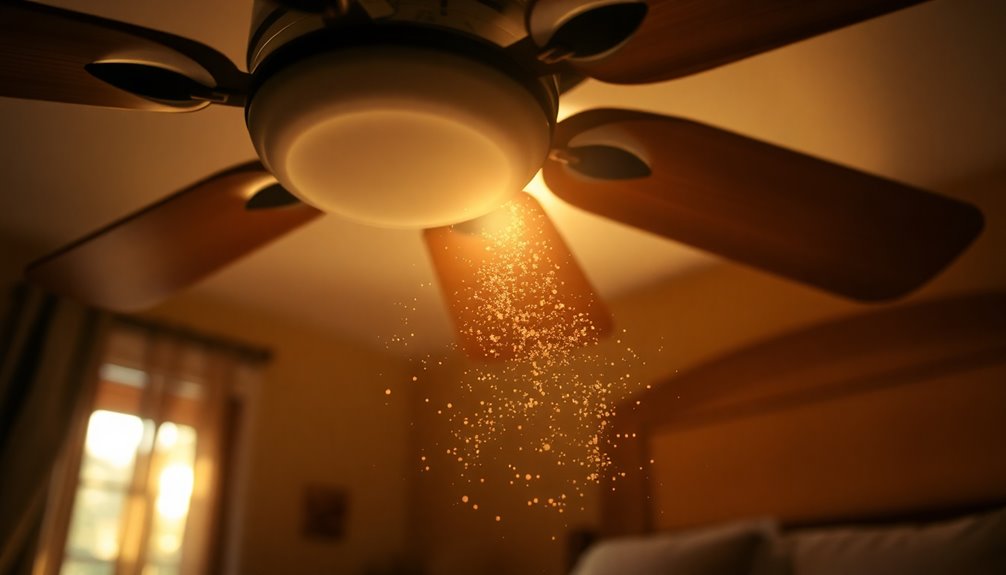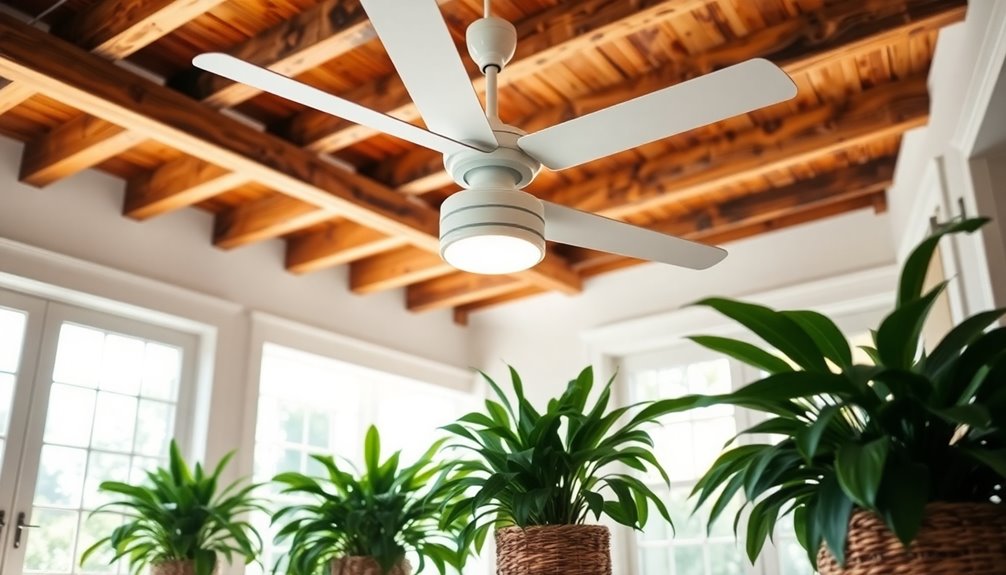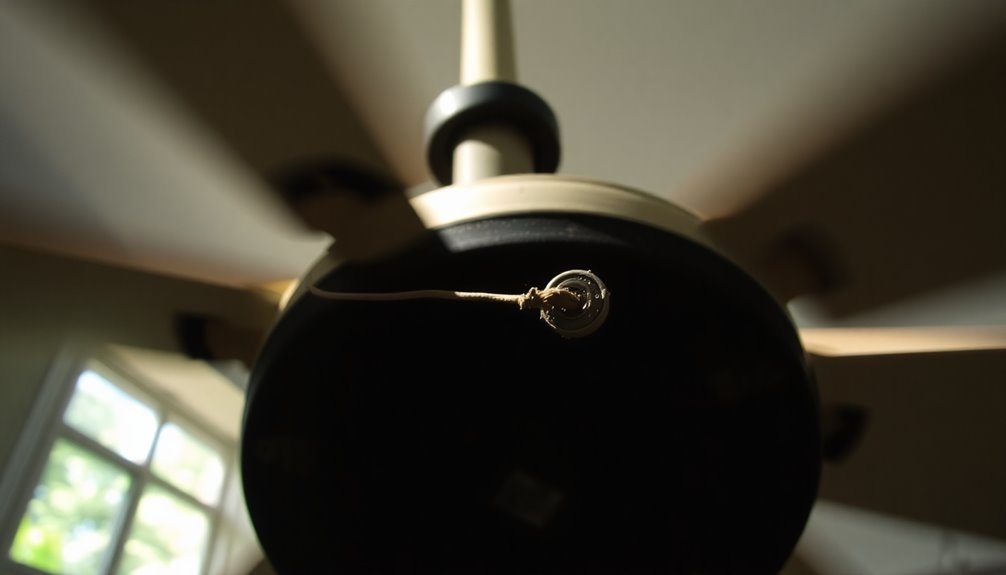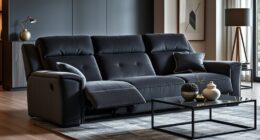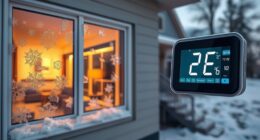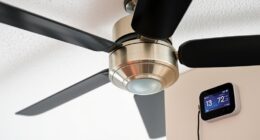In 2025, ceiling fans are all about smart home integration, letting you control them via apps and voice commands effortlessly. Expect sleek, minimalist designs with asymmetrical blades using eco-friendly materials that look modern and stylish. Energy-efficient features like DC motors and sensors help reduce power use. Outdoors, you’ll find weatherproof fans with durable components for all-weather conditions. To discover how these trends can transform your space, keep exploring the latest innovations now.
Key Takeaways
- Integration of smart home technology with voice control for seamless fan operation and automation.
- Focus on sustainable, eco-friendly materials and significant energy efficiency improvements.
- Modern, minimalist designs with innovative materials like natural wood and asymmetrical blades.
- Enhanced outdoor ceiling fans featuring weatherproof materials, corrosion resistance, and smart weather sensors.
- Continued development of durable, low-maintenance outdoor fixtures that combine style with resilience.
Seamless Smart Home Integration and Voice Control
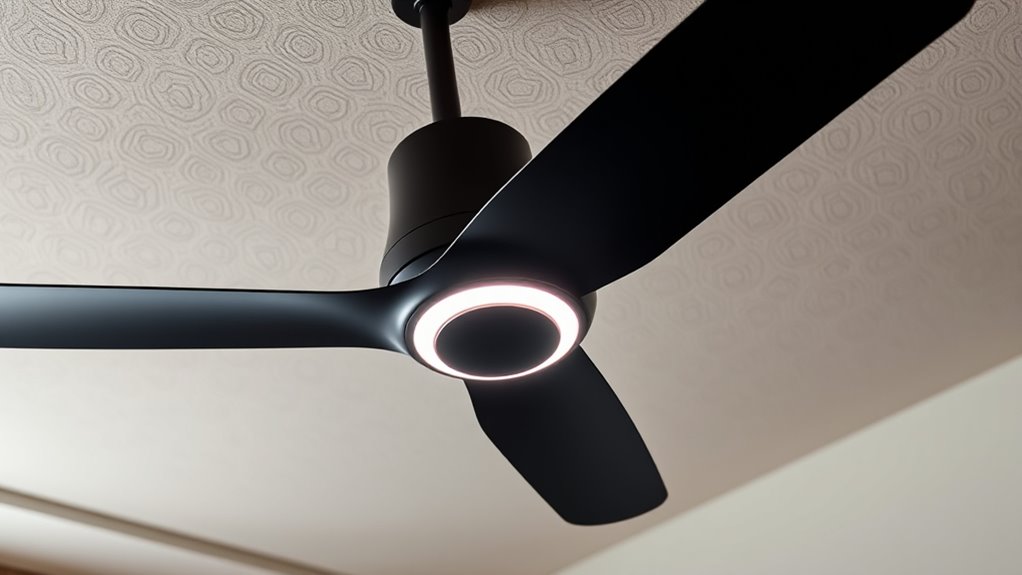
As smart home technology continues to evolve, ceiling fans have become more integrated and user-friendly than ever. Modern smart ceiling fans leverage Wi-Fi technology to connect seamlessly with your smart ecosystem, allowing you to control them via voice commands or app control.
With voice-activated features, you can turn your fan on or off, adjust speed, or set routines without lifting a finger. Automation options let you schedule fan operations and create routines that sync with other devices, such as lights or thermostats. Additionally, smart device compatibility ensures your ceiling fan works smoothly with various smart home systems, enhancing overall convenience. These compatible systems often rely on standardized protocols to ensure seamless communication across devices. Incorporating energy efficiency features helps reduce your energy consumption and lowers utility bills over time.
Many models offer real-time feedback on air quality, temperature, and energy usage, enhancing your climate control capabilities. Utilizing integrated sensors can further optimize the fan’s operation based on environmental conditions. Regular appliance maintenance and system updates ensure your smart ceiling fan continues to operate efficiently and reliably, making managing your ceiling fan intuitive and effortless, providing a smarter, more connected living experience.
Sustainable Design With Energy-Efficient Technologies
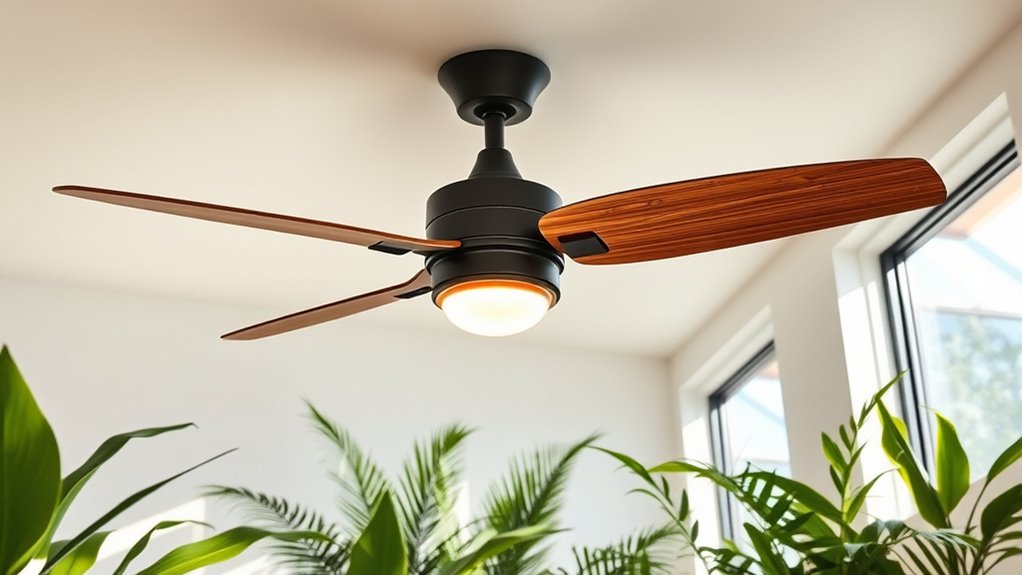
Sustainable design has become a key focus in modern ceiling fan development, with manufacturers prioritizing eco-friendly materials and energy-efficient technologies. You’ll find fans made from renewable materials like sustainably sourced wood, recycled metals, and biodegradable components that reduce environmental impact. Energy-efficient technologies, such as DC motors and smart sensors, help you save up to 64% on energy consumption. Programmable timers and motion sensors optimize operation based on occupancy and ambient conditions, further reducing waste. Fans with Energy Star certification meet strict efficiency standards, ensuring eco-conscious performance. Incorporating sustainable design principles into product development supports long-term environmental responsibility and aligns with green building standards. Additionally, the integration of renewable energy sources can further enhance the sustainability of these fans, making them an even more eco-friendly choice. Understanding energy-efficient technologies allows consumers to select fans that maximize efficiency and reduce operational costs, further supporting eco-friendly living. This focus on sustainable design allows you to enjoy effective cooling while minimizing your carbon footprint, supporting green building standards, and promoting long-term environmental responsibility. Moreover, adopting innovative manufacturing processes can reduce resource consumption and waste during production, reinforcing the commitment to sustainability and encouraging circular economy practices.
Modern Aesthetic: Sleek, Minimalist, and Asymmetrical Blades

Modern ceiling fans in 2025 embrace sleek, minimalist designs that seamlessly blend form and function. These minimalist ceiling fans feature clean lines and understated finishes, enhancing contemporary decor with subtle sophistication. Asymmetrical blades are increasingly popular, offering a distinctive modern aesthetic while optimizing airflow. Incorporating natural materials like wood or stone, these fans evoke an organic flow that adds visual interest and texture. The innovative forms of asymmetrical blades break away from traditional uniformity, emphasizing artistic expression within functional decor. Streamlined profiles hide components for a clean look, allowing the fan to serve as both a practical and stylish statement piece. This modern aesthetic prioritizes simplicity and elegance, making asymmetrical blades a key trend for contemporary interiors seeking subtle yet striking visual appeal. Additionally, innovative design options incorporate eco-friendly and sustainable materials, aligning with modern environmental values. Recognizing the importance of efficient airflow, these designs improve ventilation while maintaining a sleek appearance. Moreover, advances in motor technology contribute to quieter operation and increased energy efficiency, enhancing overall user experience. Furthermore, the integration of smart home features allows users to control fans remotely, adding convenience and modern functionality. Incorporating innovative materials further enhances durability and aesthetic appeal in these modern fans.
Multi-Functional Fixtures Combining Fans and Lighting

Multi-functional fixtures that combine ceiling fans and lighting are gaining popularity for their convenience and space-saving design. These multi-functional fixtures, like the Brookside Fandelier, seamlessly blend a ceiling fan and lighting, enhancing modern home decor. Many feature integrated LED lights for energy efficiency and a sleek look. Additionally, selecting fixtures with deterrent features can help prevent pets from scratching or damaging the units. With remote control and voice control options, these smart ceiling fans make adjusting fan speed and lighting effortless. Compact models are perfect for small spaces like bedrooms and living rooms, maximizing functionality without sacrificing style. The smart technology allows automation through platforms like Alexa, Google Assistant, or Apple HomeKit. Some models incorporate advanced fan blade designs to improve airflow and reduce noise levels. Improved airflow efficiency can lead to better cooling performance and quieter operation. Incorporating aesthetic wall organization solutions can also complement these fixtures by keeping spaces tidy and stylish. Additionally, many models are designed with easy installation features to simplify setup for homeowners. By merging airflow and lighting in one fixture, these fixtures boost efficiency and save space, making them an essential trend for 2025.
Enhanced Outdoor Durability and Weather-Resistant Features
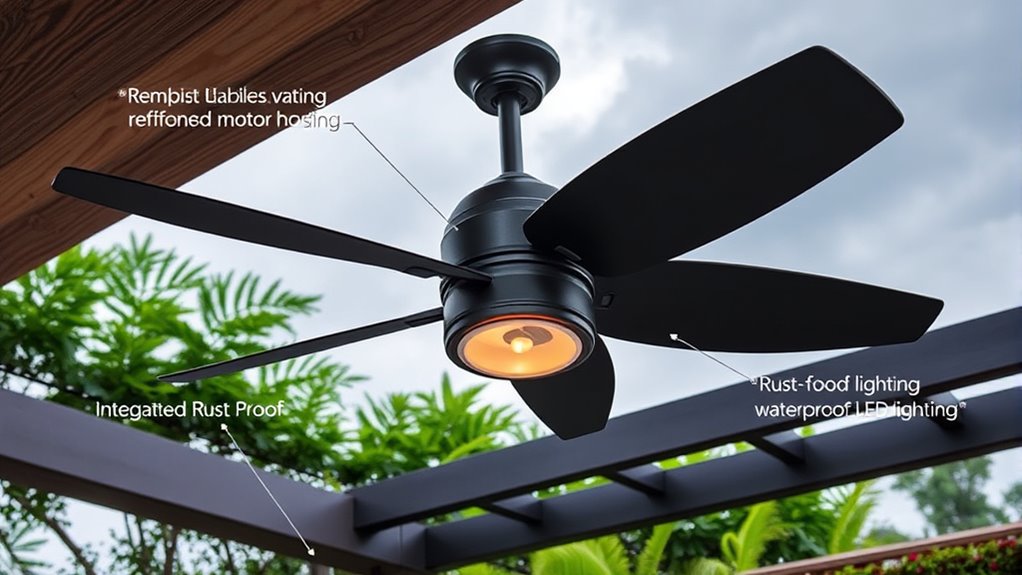
As outdoor ceiling fans become more popular, manufacturers are prioritizing durability to withstand the elements. They now feature weatherproof and weather-resistant materials like coated metals, sealed motors, and corrosion-proof blades, ensuring outdoor durability. Many models are damp-rated or wet-rated, providing moisture ingress protection against rain and humidity. Sealed junction boxes and weatherproof wiring prevent electrical failures, extending lifespan. Integrated smart weather sensors automatically adjust fan operation based on environmental conditions, boosting resilience. These outdoor fan features make your outdoor spaces more comfortable and low-maintenance. Additionally, ongoing material development and innovative design improvements are being implemented to further enhance weather resistance and longevity.
Frequently Asked Questions
How Many Years Should a Ceiling Fan Last?
You might wonder how long your ceiling fan will last. Typically, a well-maintained fan lasts about 10 to 15 years.
If you choose a high-quality model and keep it clean, it can even serve you for over 20 years. Regular maintenance, like cleaning and replacing worn parts, helps extend its life.
However, after around 15 years, it’s best to think about replacing it for safety and peak performance.
Are Ceiling Fans in Style in 2025?
You’ll find that ceiling fans are definitely in style in 2025. They blend seamlessly with modern decor thanks to their sleek, minimalist designs and natural materials like wood and stone.
Plus, smart features like Wi-Fi and voice control make them more convenient and stylish. Outdoor fans are also trending, offering both functionality and aesthetic appeal for your outdoor spaces.
What Is the Trend in Ceiling Fans?
You’ll notice ceiling fans are trending toward sleek, minimalist designs that blend effortlessly with modern decor. Natural materials like wood and artisanal glass are popular, adding organic charm.
Smart features such as app control and voice commands make them more convenient and energy-efficient.
Unique, asymmetrical blade shapes are also in style, offering a distinctive look and better performance.
What Is the New Technology in Ceiling Fans?
You should know that new ceiling fan technology includes Wi-Fi-enabled smart features, allowing you to control your fan with voice commands or apps.
Reversible blades and smart motors improve airflow and energy efficiency, while integrated LED lighting offers customizable colors and dimming.
Energy-efficient DC motors and smart sensors automatically adjust speed based on room temperature and occupancy, helping you save energy effortlessly.
These innovations combine modern aesthetics with smarter, more efficient performance.
Conclusion
As you embrace the latest ceiling fan trends, imagine a sleek, minimalist design seamlessly integrated into your smart home, effortlessly controlled by your voice. Meanwhile, durable outdoor fans stand resilient against the elements, combining style with weatherproof performance. These innovations blend modern aesthetics with sustainable, multi-functional features, transforming your space into a haven of comfort and efficiency. In 2025, your home becomes both a sleek sanctuary and a resilient retreat—where cutting-edge technology meets timeless design.

